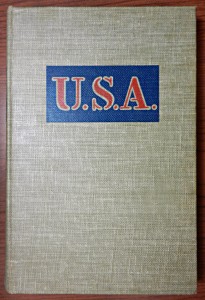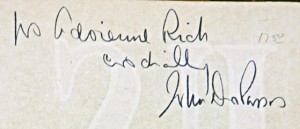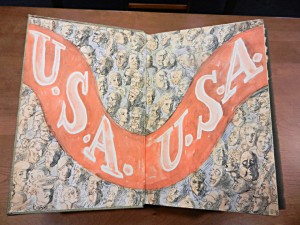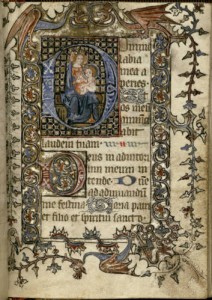
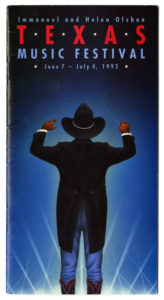
Program from the Immanuel and Helen Olshan Texas Music Festival Records, 1992
Each summer the Immanuel & Helen Olshan Texas Music Festival provides an opportunity for talented young musicians to come together and learn from professional musicians as well as faculty from the Moores School of Music. This year’s festival performances kicked off June 11 and run through July 2.
In 2013, the University Archives acquired records documenting the history of this distinctive program. The recently processed Immanuel and Helen Olshan Texas Music Festival Records contain concert programs, publicity and press materials, a scrapbook, as well as concert recordings covering the history of the festival from 1985 to 2013.
In addition to documenting a vital part of the city and the University’s musical landscape, the Immanuel & Helen Olshan Texas Music Records also exemplify the changing nature of the archival record, and the challenges repositories face along with it. While the paper portion of the TMF records is comparatively small, the records also include over 200 digital recordings. These recordings arrived on CDs, an unstable media not suitable for long-term archival storage. The TMF records arrived just as the department was beginning to explore in earnest methods for accessioning born digital materials and transferring files to secure digital archival storage. As Special Collections has continued to acquire collections containing a variety of digital media formats, we continue to improve our processes for preserving, describing, and providing access to these materials.
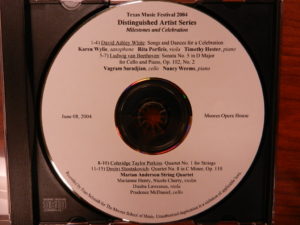
Texas Music Festival Distinguished Artist Series Milestones and Celebration concert recording, June 8, 2004
For now, the digital concert recordings are minimally described in the finding aid with an overview of what is available, including the date range of recordings. Researchers, performers, or fans wanting to get more detail on the recordings—including dates, soloists and conductors, and pieces played for specific concerts—are encouraged to contact University Archivist Mary Manning with inquiries. With advance request, the concert recordings can be made available for listening on a computer in our reading room.
As they record a dynamic cultural and educational event, it is only appropriate that the Immanuel and Helen Olshan Texas Music Festival Records also help orchestrate a transition in the archives to a new era in collecting, preserving, and making accessible our cultural heritage.
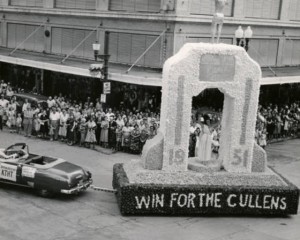
Homecoming Parade Float, “Win For The Cullens” (1951, UH Photographs Collection)
Homecoming Week is upon the University of Houston, and the University Archives and Special Collections are joining in the celebration. Last year, you may recall, the archives worked with other library partners to launch a virtual exhibit, UH Homecoming through the Years. This year, the Homecoming Board, Council of Ethnic Organizations, and University Archives have partnered to produce a collaborative Homecoming exhibit entitled “A Look Back at UH Homecoming.” Representatives from these groups have been meeting for months, brainstorming ideas, coordinating research in the archives, and planning for the exhibit and related events. University Archives staff have provided guidance on using the archives and shared resources on the history of homecoming and the University. Meanwhile, the students brought their energy and vision of a Varsity Red Homecoming and selected the materials and stories they wanted to highlight in the exhibit. Homecoming marked a perfect opportunity for this sort of collaboration, and the new exhibit looks great!
The exhibit focuses on the early days of homecoming at UH, and covers events ranging from the first Homecoming in 1946 to the crowning of UH’s first African-American homecoming queen in 1968. In keeping with the Homecoming Board’s theme for the year, the exhibit seeks to inform students about the origins of homecoming at UH, instill Cougar pride, and highlight some of the traditions that have been a part of this campus celebration over the years.
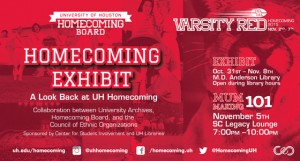 The exhibit is currently on display in front of Special Collections on the second floor of the M.D. Anderson Library. It will be there throughout Homecoming Week, with one very special exception. As a part of the week’s festivities, the exhibit will be hitting the road! Making a rare trip outside of Special Collections, these University Archives materials included in the exhibit will be featured during the Homecoming Board’s Mum-Making 101 event, which takes place Legacy Lounge in the Student Center on Thursday, November 5. The artifacts will be on display there from 7-8pm, while the event goes on till 10pm. The next day, the exhibit will pop back up in front of Special Collections, where it will remain on display through November 13th.
The exhibit is currently on display in front of Special Collections on the second floor of the M.D. Anderson Library. It will be there throughout Homecoming Week, with one very special exception. As a part of the week’s festivities, the exhibit will be hitting the road! Making a rare trip outside of Special Collections, these University Archives materials included in the exhibit will be featured during the Homecoming Board’s Mum-Making 101 event, which takes place Legacy Lounge in the Student Center on Thursday, November 5. The artifacts will be on display there from 7-8pm, while the event goes on till 10pm. The next day, the exhibit will pop back up in front of Special Collections, where it will remain on display through November 13th.
In addition to the over 7,000 linear feet of archival collections made available for study at the University of Houston Special Collections, we are also proud to offer over 100,000 rare and antique books for use in our reading room. Each month we will highlight a text from our collections and what makes it so special. This month, Matt Richardson shares John Dos Passos’ Nineteen Nineteen from the U.S.A. trilogy.
John Dos Passos’ U.S.A. is a sprawling look at American life in the early 20th century that takes place across 3 novels, several decades, and over 1000 pages. Consisting of the novels The 42nd Parallel (1930), Nineteen Nineteen (1932), and The Big Money (1936), it was first published as single volume in 1938 by Harcourt Brace. In addition to the rather straightforward narrative passages, Dos Passos’ work incorporates collections of headlines and popular songs in “Newsreel” segments, impressionistic renderings called the “Camera Eye,” and short biographies, often satiric, of prominent Americans. Beyond the complexity and innovation of the form itself, the element that typically garners the most critical attention is the cinematic stream of consciousness Camera Eye, which often elicits comparisons to Joyce. Though the novels purport to be the epic of one nation, Dos Passos’ U.S.A. inevitably overflows those boundaries, as it is filled with characters who frequently journey abroad and are continually shaped by their imaginings of and interactions with the wider world. This perspective is especially apparent in the middle novel of the trilogy, Nineteen Nineteen, which focuses on the trying years of World War I and the unsettled peace that followed it.
UH Libraries’ Special Collections has the distinct pleasure of holding a 1946 printing of Nineteen Nineteen signed by Dos Passos himself. Interestingly, the inscription reads: “To Adrienne Rich cordially John Dos Passos”. How the author might have encountered the American poet, essayist, and feminist, or for that matter how the University of Houston Libraries Special Collections later came into possession of her copy, would no doubt make for an interesting tale in its own right. (Though it’s not her only appearance in our collections). And since this 1946 printing was originally issued as a box set by Houghton Mifflin, one wonders what became of its companion copies of The 42nd Parallel and The Big Money. Bound in rather austere tan buckram with a stencil-style “U.S.A.” stamped across a small blue field, the exterior of the book almost evokes a government provision of the type Dos Passos’ enlisted men might receive. In contrast, the interior includes vivid end-sheets and illustrations by Reginald Marsh.
And should the 1000+ page epic constitute more time than you can devote to our reading room, fear not! After you’ve taken a look at our signed copy here in Special Collections, you’ll be pleased to find circulating copies of the U.S.A. trilogy in the general collections stacks of the M.D. Anderson Library.
Whether it’s a rare book printing found at long last or piece of ephemera found in an archival collection by chance, those who visit the University of Houston Special Collections almost always find something they cannot wait to share with others. Here we celebrate what makes the University of Houston Special Collections so special–our Favorite Things.
This series is intended to shine a light on some of the most prized things we find here in Special Collections. Sometimes, however, we are reminded that the most special of all aren’t the objects that reside in our stacks, but the people who walk through our doors.
Not long ago I was witness to a special treat in the reading room. Headed out to our foyer desk to greet a patron, I was somewhat surprised when I encountered an elementary school-aged child. While a family member searched the general stacks, this young girl had intrepidly set out in search of older, rarer quarry.
I thought of all the amazing rare books in our collections, and tried to come up with the perfect example to share. Just before we went into the reading room to begin viewing materials, we were joined by Pat Bozeman, Head of Special Collections. Her mind quickly went to the Book of Hours, Use of Reims as a treat worthy of such a delightful and curious patron.
Watching the young researcher excitedly encounter this book was one of my favorite moments since joining the UH Libraries. It was a pleasure to watch and listen as Pat explained how the book was made and pointed out interesting details to a completely captivated child. And the girl’s reactions were a reminder of the wonder that these fantastic holdings have the power to elicit. There are lots of great things about working in the reading room, but there isn’t much that can top a child’s sincere “wow!”
The experience not only underscored the responsibility we here in Special Collections have for preserving and making accessible our cultural heritage, but was also a reminder of just how darn lucky we are to get to do it.
